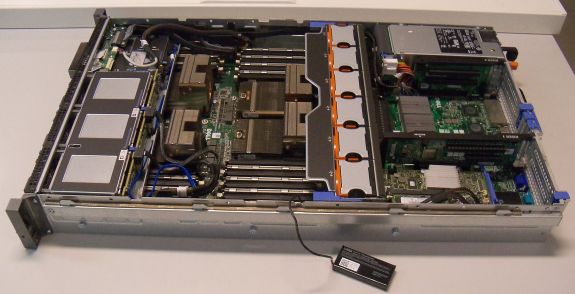Server Clash: DELL's Quad Opteron DELL R815 vs HP's DL380 G7 and SGI's Altix UV10
by Johan De Gelas on September 9, 2010 7:30 AM EST- Posted in
- IT Computing
- AMD
- Intel
- Xeon
- Opteron
Quad Opteron Style Dell
Offering an interesting platform is one thing. The next challenge is to have an OEM partner that makes the right trade-offs between scalability, expandability, power efficiency and rack space. And that is where the DELL R815 makes a few heads turn: the Dell R815 is a 2U server just like the dual Xeon servers. So you get almost twice the amount of DIMM slots (32) and twice the amount of theoretical performance in the same rack space. Dell also limited the R815 to four 115W Opteron 6100 CPUs (quad 137W TDP Opteron SE is not possible). This trade-off should lower the demands on the fans and the PSU, thus benefiting the power efficiency of this server.
Compared to its most important rival, the HP DL585, it has fewer DIMM slots (32 vs. 48) and PCIe slots. But it is again a balanced trade-off: the HP DL585 is twice as large (4U) and quite a bit pricier. An HP DL585 is 30 to 40% more expensive depending on the specific model. HP positions the quad opteron DL585 right in the middle between the HP DL380 G7 (Dual Xeon 5600) and the HP DL580 (Quad Xeon 7500). The HP DL585 seems to be targeted to the people who need a very scalable and expandable server but are not willing to pay the much higher price that comes with the RAS focused Xeon 7500 platform.
Dell’s R815 is more in line with the “shattering the 4P tax” strategy: it really is a slightly more expensive, more scalable alternative to the Dual Xeon 5600 servers. Admittedly, that analysis is based on the paper specs. But if the performance is right and the power consumption is not too high, the Dell R815 may appeal to a lot of people that have not considered a quad socket machine before.
Most HPC people care little about RAS as a node more or less in a large HPC cluster does not matter. Performance, rack space and power efficiency are the concerns, in that order of importance. The HPC crowd typically goes for 1U or 2U dual socket servers. But in search for the highest performance per dollar, twice the amount of processing power for a 30% higher price must look extremely attractive. So these dual socket buyers might consider the quad socket R815 anyway.
As a building block for a virtualized datacenter, the R815 makes a good impression on paper too: virtualized servers are mostly RAM limited. So if you do not want to pay the huge premium for 16GB DIMMs or Quad Xeon 7500 servers with their high DIMM slot counts, the R815 must look tempting.
In short, the quad Opteron 6100 Dell R815 could persuade a lot of people on two conditions. The first one is that the two extra CPUs really offer a tangible performance advantage, and that this happens with a minor power increase. So can the Dell R815 offer a superior performance/watt ratio compared to the dual Xeon 5600 competition? Well, that is what this article will try to find out. Let us take a closer look at the benchmarked configurations of the three competitors: the Dell PowerEdge R815, the HP Proliant DL380 G7 (dual Xeon X5670) and the QSCC-4R / SGI Altix UV10.











51 Comments
View All Comments
Chrisrodinis - Thursday, February 27, 2014 - link
This article is about Dell servers in 2010. For comparison purposes here is an overview of a Dell PowerEdge M420 Blade server. This video has cool effects with upbeat production values. Please check it out, thanks: https://www.youtube.com/watch?v=iKIG430z0PI